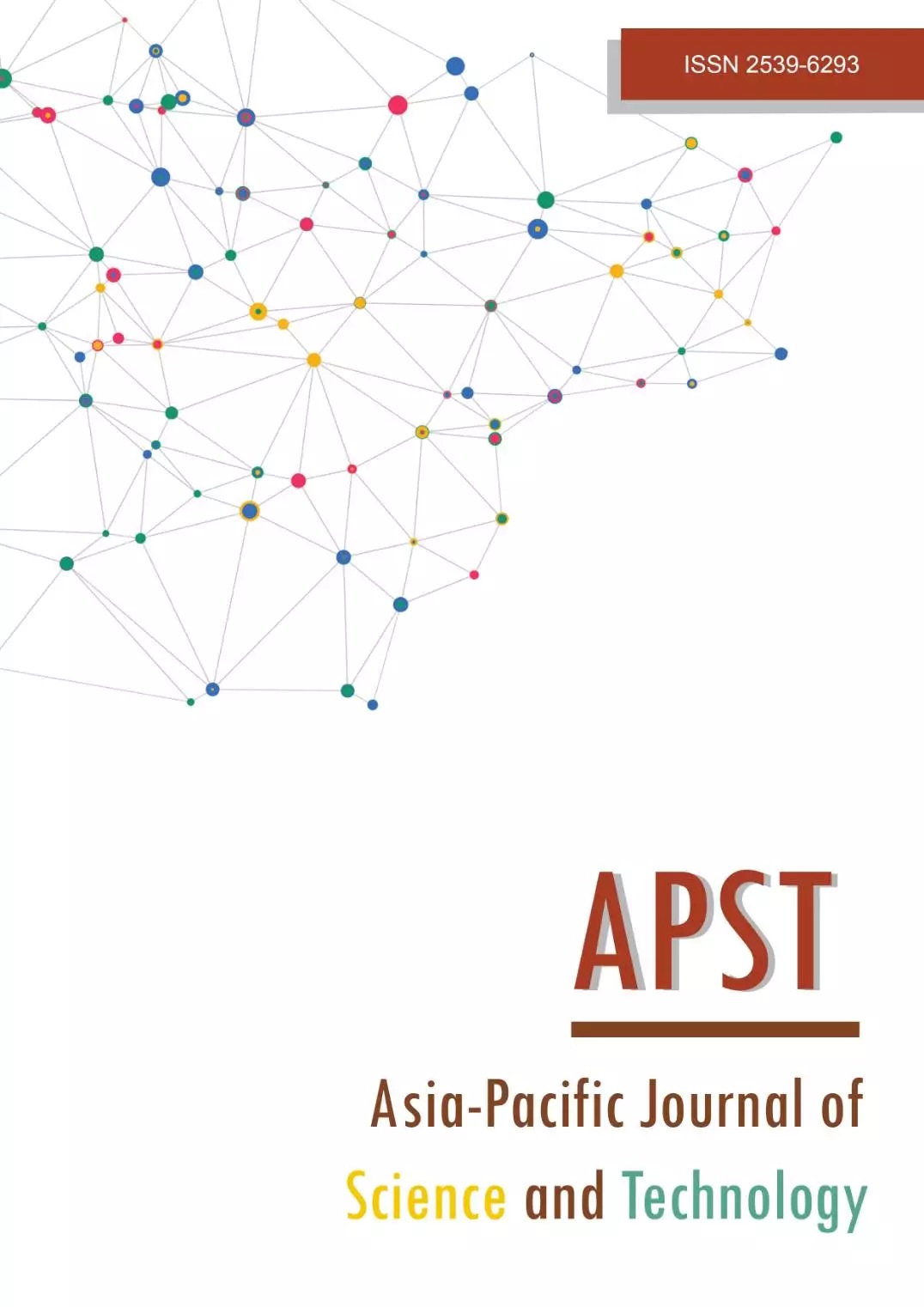Molecular markers for resistant starch content in Thai rice
Main Article Content
Abstract
Resistant starch (RS) is the starch that is not digested in the gastrointestinal tract. It is fermented to become a prebiotic that is beneficial to human health. This research aimed to find molecular markers linked to RS content in rice. The correlations between RS content and molecular markers specific to SSIIIa, SBEIIb and Waxy genes, which have been reported to affect RS content, were tested in an F2 population from two crosses_-RD-Maejo 2 RD43, which are glutinous and non-glutinous rice respectively, and Pathum Thani 1 Jao Leuang, which are both non-glutinous rice but have different amylose contents. The results showed that the RS content of 100 F2 plants from RD-Maejo 2 RD43 significantly correlated with the marker specific to starch type in the Waxy gene (r = 0.704, p < 0.001), and non-glutinous rice contained more RS content than glutinous rice. Likewise, the RS content of 92 F2 plants from Pathum Thani 1 Jao Leuang significantly correlated with the marker specific to SNP in exon 10 of the Waxy gene (r = 0.682, p < 0.001). Rice with the high amylose allele from Jao Leuang had more RS content than rice with the low amylose allele from Pathum Thani 1. Positive correlation between RS content and amylose content was revealed (r = 0.837, p < 0.001). The results indicate that amylose content correlates with RS content and molecular markers of the Waxy gene can be used for rice screening when high RS content is concerned.
Article Details

This work is licensed under a Creative Commons Attribution-NonCommercial-NoDerivatives 4.0 International License.
References
Perera A, Meda V, Tyler RT. Resistant starch: A review of analytical protocols for determining resistant starch and of factors affecting the resistant starch content of foods. Food Res Int. 2010;43(8):1959-1974.
Nugent AP. Health properties of resistant starch. Nutr Bull. 2005;30:27-54.
Rai AK, Singh N, Rani R, Shingh S. Resistant starch and its health benefits. Trends Biosci. 2019;12(12):905-908.
Shen L, Li J, Li Y. Resistant starch formation in rice: Genetic regulation and beyond. Plant Commun. 2022;3:100329.
Zhou H, Wang L, Liu G, Meng X, Jing Y, Shu X, et al. Critical roles of soluble starch synthase SSIIIa and granule-bound starch synthase Waxy in synthesizing resistant starch in rice. PNAS. 2016;113(45): 12844-12849.
Yang R, Sun C, Bai J, Luo Z, Shi B, Zhang J, et al. A Putative gene sbe3-rs for resistant starch mutated from SBE3 for starch branching enzyme in rice (Oryza sativa L.). PLoS One. 2012;7(8):e43026.
Yang R, Bai J, Fang J, Wang Y, Lee G, Piao Z. A single amino acid mutation of OsSBEIIb contributes to resistant starch accumulation in rice. Breed Sci. 2016;66(4):481-489.
Kumar A, Sahoo U, Lal MK, Tiwari RK, Lenka SK, Singh NR, et al. Biochemical markers for low glycemic index and approaches to alter starch digestibility in rice. J Cereal Sci. 2022;106:103501.
Zhang Z, Li M, Fang Y, Liu F, Lu Y, Meng Q, et al. Diversification of the Waxy gene is closely related to variations in rice eating and cooking quality. Plant Mol Biol Rep. 2012;30:462-469.
Bao JS, Zhou X, Xu FF, He Q, Park YJ. Genome-wide association study of the resistant starch content in rice grain. Starke. 2017;69:1600343.
Department of Foreign Trade, Ministry of Commerce. Thai rice for life. Nonthaburi: Sirivatana Interprint Public Company Limited; 2016. p. 164.
Department of Foreign Trade, Ministry of Commerce. Thailand standards for rice [internet]. 2016 [cited 2022 Nov 11]. Available from: https://www.dft.go.th/Portals/49/ebook/12_Thailand-Standard-for-Rice.pdf.
International Rice Genome Sequencing Project. The map-based of the rice genome. Nature. 2005;436: 793-800.
Wanchana S, Tragoonrung S, Toojinda T, Vanavichit A. Duplicated coding sequence in the waxy allele of tropical glutinous rice (Oryza sativa L.). Plant Sci. 2003;165(6):1193-1199.
Doyle JJ, Doyle JL. A rapid DNA isolation procedure for small quantities of fresh leaf tissue. Phytochem Bull. 1987;19:11-15.
Bhonsle SJ, Sellappan K. Grain quality evaluation of traditionally cultivated rice varieties of Goa, India. Rec Res Sci Tech. 2010;2(6):88-97.
R Core Team. R: A language and environment for statistical computing. R Foundation for Statistical Computing, Vienna, Austria [internet]. 2022 [cited 15 July 2022]. Available from https://www.R-project.org.
Biselli C, Volante A, Desiderio F, Tondelli A, Gianinetti A, Finocchiaro F, et al. GWAS for starch-related parameters in Japonica rice (Oryza sativa L.). Plants (Basel). 2019;8(292):1-22.
Englyst H, Kingman S, Cummings J. Classification and measurement of nutritionally important starch fractions. Eur. J. Clin. Nutr. 1992;46(Suppl.):S33-S50.
Goni I, Garcia-Alonso A, Saura-Calixto F. A starch hydrolysis procedure to estimate glycemic index. Nutr. Res. 1997;17:427-437.
Yang CZ, Shu XL, Zhang LL, Wang X, Zhao H, Ma CX, et al. Starch properties of mutant rice high in resistant starch. J Agric Food Chem. 2006;54(2):523-528.
Chen MH, Bergman CJ, McClung AM, Everette JD, Tabien RE. Resistant starch: Variation among high amylose rice varieties and its relationship with apparent amylose content, pasting properties and cooking methods. Food Chem. 2017;234(2017):180-189.
Patindol JA, Guraya HS, Champagne ET, McClung AM. Nutritionally important starch fractions of rice cultivars grown in southern United States. J Food Sci. 2010;75(5):H137-H144.
Nakayoshi Y, Nakamura S, Kameo Y, Shiiba D, Katsuragi Y, Ohtsubo K. Measurement of resistant starch content in cooked rice and analysis of gelatinization and retrogradation characteristics. Biosci Biotechnol Biochem. 2015;79(11):1860-1866.
Fitzgerald MA, Rahman S, Resurreccion AP, Concepcion J, Daygon VD, Dipti SS, et al. Identification of a major genetic determinant of glycaemic index in rice. Rice. 2011;4:66-74.
Kumar A, Sahoo U, Baisakha B, Okpani OA, Ngangkham U, C P. Resistant starch could be decisive in determining the glycemic index of rice cultivars. J Cereal Sci. 2018;79:348-353.
Prasad VSS, Hymavathi A, Babu VR, Longvah T. Nutritional composition in relation to glycemic potential of popular Indian rice varieties. Food Chem. 2018;238:29-34.
Shu X, Jia L, Gao J, Song Y, Zhao H, Nakamura Y, et al. The influences of chain length of amylopectin on starch in rice (Oryza sativa L.). Starke. 2007;59(2007):504-509.
Hasan N, Choudhary S, Naaz N, Sharma N, Laskar RA. Recent advancements in molecular marker-assisted selection and applications in plant breeding programmes. J Genet Eng Biotechnol. 2021;19:128.


